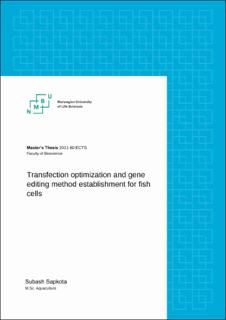| dc.contributor.advisor | Sandve, Simen Rød | |
| dc.contributor.advisor | Dahle, Maria K | |
| dc.contributor.advisor | Monjane, Aderito Loius | |
| dc.contributor.author | Sapkota, Subash | |
| dc.date.accessioned | 2021-09-03T13:12:59Z | |
| dc.date.available | 2021-09-03T13:12:59Z | |
| dc.date.issued | 2021 | |
| dc.identifier.uri | https://hdl.handle.net/11250/2772914 | |
| dc.description.abstract | Aquaculture is one of the fastest-growing industries around the world, and salmonoid aquaculture is a very big industry for Norway. Ensuring fish health and welfare is essential for aquaculture, also to avoid economic loss. To solve these challenges, researchers need to build new knowledge and understanding through research. To avoid the overuse of fish for in-vivo experiments, researchers need good in vitro cell models. Such cell models can be used to study the effects of infectious diseases, environmental impact, and functions of associated genes with the help of gene editing. Effective and optimized methods are essential for successful gene editing using the CRISPR Cas9 method. Electroporation is a very effective method for the transfection of cell lines. This project was aimed to optimize transfection protocols for fish gill cell lines using two electroporation methods and attempting to perform genome sediting based on the CRISPR/CAS9 system in the Atlantic salmon gill (ASG)-10 cell line.
Fish cell lines (ASG-10 and LG-1) developed within the Veterinary Institute of Norway were transfected using pmaxGFPTM plasmid and eSpCas9-GFP protein, on the NeonTM transfection system and NucleofectorTM 2b electroporation devices. Transfected cells were analyzed using a fluorescence microscope and flow cytometry. The best program identified was used for CRISPR-Cas9 transfection in the ASG-10 cell line. CYP1a was used as a target gene as it is important for detoxification, functional assays were available, and the gene is expressed in ASG-10. Two different Cas9 enzymes were used (GFP tagged and untagged) to make ribonucleoprotein (RNP) complexes. The analysis of gene editing from CRISPR-Cas9 transfection was performed using Cleavage assay and Sanger sequencing. From the analysis, edits were not detected, most likely due to low editing efficiency.
The master project was successful in optimizing transfection protocols for plasmid and protein transfection in gill cell lines, as well as in establishing a CRISPR-Cas9 gene editing workflow. | en_US |
| dc.description.sponsorship | Norwegian veterinary institute (NVI) | en_US |
| dc.language.iso | eng | en_US |
| dc.publisher | Norwegian University of Life Sciences, Ås | en_US |
| dc.rights | Attribution-NonCommercial-NoDerivatives 4.0 Internasjonal | * |
| dc.rights.uri | http://creativecommons.org/licenses/by-nc-nd/4.0/deed.no | * |
| dc.title | Transfection optimization and gene editing method establishment for fish cells | en_US |
| dc.type | Master thesis | en_US |
| dc.subject.nsi | VDP::Landbruks- og Fiskerifag: 900 | en_US |
| dc.description.localcode | M-AA | en_US |

